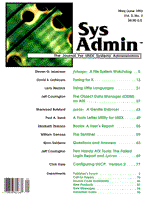
Listing 2: fcdiff
:
#######################################################
# fcdiff: show the last two changes in an fchange log
# file. changes begin with the #_change tag.
test "$debugxv" && set -xv # primitive debugger
fchff=fchange.files
logdir=logs
test -f $fchff || {
echo "Error: could not find $fchff"
echo "you must be in fchangedir"
exit 1
}
#######################################################
# syntax
#######################################################
syntax()
{
echo "\
Usage: `basename $0` [-n log number] [-f filename]"
exit 1
}
# syntax()
#######################################################
test $# = 0 && syntax
# process the command-line
set -- `getopt n:f: $*` || syntax
unset lognum filename
while [ $# -gt 0 ]
do
case "$1" in
-n) lognum="$2" ; shift ;;
-f) filename="$2" ; shift ;;
--) shift ; break ;;
*) echo "illegal option: $1"; exit -1 ;;
esac
shift
done
test "$lognum" || test "$filename" || {
echo "Error: must specify number or filename"
exit 1
}
unset trackn
test "$lognum" && trackn=${logdir}/${lognum}.log.track || {
grep "$filename" $fchff
exit 0
}
test -f $trackn || {
echo "Error: couldn't find: $trackn"
exit 1
}
filea=/tmp/junk1 ; > $filea
fileb=/tmp/junk2 ; > $fileb
lines=`awk '/^#_change/ {print NR}' $trackn | tail -2`
# $lines will equal something like "45 100". the for x
# that follows simply sets a=45 and b=100.
for x in $lines
do
test "$a" && b=$x || a=$x
done
echo "start=$a end=$b"
# print out the first section, which starts at the first
# line number and ends at before the second line number.
awk '{ if (NR >= linea && NR < lineb ) { print }
}' linea=$a lineb=$b $trackn > $filea
# print out the last entry, which begins at the second
# line number.
awk '{ if (NR >= lineb) { print } }' lineb=$b $trackn \
> $fileb
# show what has changed
diff $filea $fileb
rm -f $filea $fileb
exit 0
|